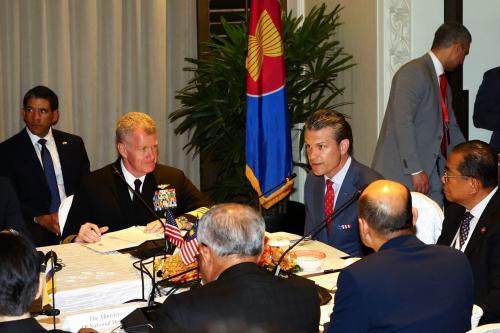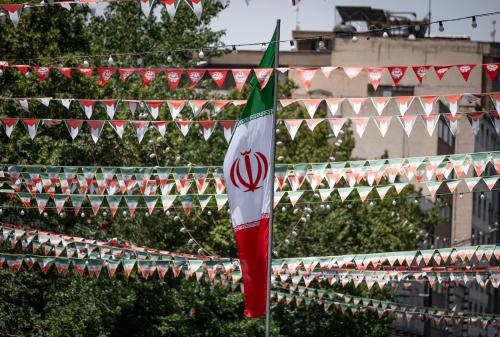Do we have the military wherewithal to overthrow Saddam Hussein anytime soon? According to recent reports, the nation’s top military officers are not entirely sure.
Part of their hesitation is based on the view that such a war could entail bloody urban combat, involving biological and chemical arms. But some of the Joint Chiefs of Staff, as well as several of the nation’s regional military commanders, also maintain that their forces are already overstretched from Afghanistan to the Balkans to Northeast Asia to the Persian Gulf. Without precluding the possibility of a war against Saddam, they clearly believe it could push the military nearly to the breaking point.
The military’s wariness about fighting on the streets of Baghdad is well-founded. Iraq’s military is now accustomed to American bombing and would not let itself be attacked in fixed trench lines in open terrain, as it did in Desert Storm and as the Taliban and al Qaeda did in Afghanistan. And whatever Iraq’s run-of-the-mill conscripts might do, its 100,000-strong Republican Guard and Special Republican Guard units would not quickly capitulate to the Kurdish-dominated opposition. Whether they would capitulate to American ground forces is another matter, but hardly something to be assumed.
But the Joint Chiefs’ worries about an overstretched U.S. military are harder to understand. They also run the risk of emboldening our adversaries. Even those of us dubious about the need to overthrow Saddam should not want U.S. enemies, who already consider us casualty-averse, to believe we are militarily handicapped from quick response to any aggression.
The U.S. military, we have been told for a decade, is sized and structured to fight two major wars at once. Each conflict has been expected to require up to 500,000 American troops. The Bush administration has recently determined such a goal may have been impractical, but still claims the capability to wage one such all-out war and a second major operation perhaps half as big. In all, that could involve about 750,000 U.S. troops in combat.
By comparison, today’s demands are modest, and they would remain well within our capabilities even if we went to war against Saddam. Operations in Afghanistan and the Persian Gulf together now require about 60,000 American personnel; the ongoing commitments in the Balkans involve another 10,000; smaller missions of various types in the Philippines, Georgia, Yemen and the Sinai add fewer than another 10,000. Post-9/11 security measures at military bases around the world might involve 50,000 more troops. Adding in 250,000 GIs to overthrow Saddam, all war-related deployments combined would involve about 400,000 troops—a substantial number, to be sure, but only about half the total we are supposed to be able to deploy at once.
A more detailed military analysis leads to the same conclusion. Consider:
Main combat forces. We have enough to deploy 250,000 troops, including four to five ground combat divisions and 12 to 15 air combat wings, to the Persian Gulf. Today’s U.S. military has 13 active-duty divisions (10 in the Army, three in the Marine Corps). Less than one full division is presently involved in the Afghanistan campaign; less than one is in the Balkans; small pieces of other divisions are deployed elsewhere. That leaves more than 10 divisions available. Even after excluding the Army’s Second Infantry Division in South Korea, the Korea-oriented 25th Infantry Division in Hawaii, and the Pacific-oriented Third Marine Force in Okinawa, we would have more than ample ground troops to overthrow Saddam and occupy Iraq.
A similar conclusion holds for air power. There are 20 tactical fighter wings in the Air Force, 11 in the Navy, and three in the Marine Corps. Of that grand total, only about 10 would be unavailable based on existing commitments in the Western Pacific and Afghanistan. And the dozen bombers that have typically flown over Afghanistan constitute just 10% of total U.S. capability.
Key support forces. Certain critical forces, ranging from aerial tankers to transport aircraft to special operations units to unmanned aerial vehicles, have been heavily used in Afghanistan. But even at its peak, Afghanistan did not place higher demands on most of these support capabilities than would a so-called major theater war. And today the tempo of operations is less than half what it once was, while allied combat forces are providing considerable help in the ongoing search for Taliban and al Qaeda fighters.
The U.S. military today owns some 600 refueling aircraft, of which more than 400 are airworthy at present. They have been heavily used in Afghanistan. But they are presently flying fewer than 50 sorties a day in support of Operation Enduring Freedom. Most would be available should the bell toll for Saddam.
Ammunition. Much has also been made of the depleted inventories of precision munitions in the aftermath of last fall’s intensive aerial operations, including satellite-guided joint direct attack munitions, or JDAM. But this concern is easily exaggerated when considering the feasibility of a war against Saddam. Stocks of most other ordnance, including Maverick and Hellfire missiles, appear ample based on unclassified estimates. Inventories of laser-guided bombs may not be full, but are surely considerable given how many were used in Afghanistan.
We did not even have JDAM the last time we fought Iraq. And we might not be able to make much use of it in urban combat anyway since it typically misses its targets by 10 yards or so (meaning that a bomb aimed at Iraqi troops might hit a hospital instead). But we are producing more quickly, and inventories will be substantially larger by the end of the year—the soonest we would plausibly fight Iraq, given that months of preparations needed before any conflict.
Transportation. Finally, what about getting to the fight? Most U.S. sealift has hardly been used in Afghanistan and would be quickly available for a war against Iraq. That fleet is by far its strongest ever; a largely unsung accomplishment of the Clinton administration was the construction of almost 20 large roll-on/roll-off ships for rapid transport of equipment. Airlift has been much more heavily used in Afghanistan. But current operations there involve a quarter of the total U.S. capability, at most.
None of this is to suggest that war against Saddam is a good idea or a necessary option. Nor does it solve the diplomatic problem of gaining wartime access to bases in the Persian Gulf. But American adversaries should have no doubt about our ability to mount a large-scale military operation, and to do it soon if necessary.
The Brookings Institution is committed to quality, independence, and impact.
We are supported by a diverse array of funders. In line with our values and policies, each Brookings publication represents the sole views of its author(s).



Commentary
Op-edWe’re Ready To Fight Iraq
May 29, 2002